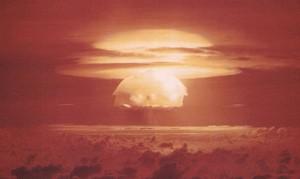Missing nukesCanada to investigate object that could be a nuke lost in 1950
The Royal Canadian Navy is to investigate an object found by a diver off the coast of Queen Charolette Islands, suspecting it could be a “lost nuke” which was lost off the coast of Canada since 1950. On 13 February 1950, three of the engines of a U.S. Air Force B-36 bomber aircraft caught fire while flying from Alaska to Texas. The plane was on a training mission, planning to carry out a simulated nuclear attack on San Francisco. The crew decided to drop the bomb into the Pacific Ocean before bailing out because they were unsure of how close they were to populated areas.

Frightening when lost // Source: tamu.edu
The Royal Canadian Navy is to investigate an object found by a diver off the coast of Queen Charolette Islands, suspecting it could be a “lost nuke” which was lost off the coast of Canada since 1950.
The BBC reports that Sean Smyrichinsky discovered it while fishing near Haida Gwaii, British Columbia. Experts say it could be a dummy nuclear bomb – likely still loaded with TNT – lost after the crew of a training flight encountered mechanical problems and ditched the bomb into the sea before crashing.
“I found something that I’d never ever seen before,” Smyrichinsky told the CBC. “It resembled, like, a bagel cut in half, and then around the bagel these balls all cut into it, molded into it… It was the strangest thing that I had ever seen.”
Smyrichinsky sketched what he saw on a napkin, and initially thought it could have been a UFO. When he mentioned it to an old fisherman from the area, that fisherman said it could be a bomb that went missing more than five decades ago.
The BBC says that on 13 February 1950, three of the engines of a U.S. Air Force B-36 bomber aircraft caught fire while flying from Alaska to Texas. The plane was on a training mission, planning to carry out a simulated nuclear attack on San Francisco.
Its payload was a Mark IV nuclear bomb, weighing nearly five tons. It had a lead core instead of plutonium, and was thus unable to cause a nuclear explosion, but it was still a real device loaded with explosives.
The co-pilot of the flight explained in a 1998 interview why this was done: “Without a real bomb the support systems could not be tested. There were some dummy bombs made of concrete that were used for load testing, but we weren’t carrying one of those.
“This mission was to be as real as it gets short of war…The large amount of TNT in the bomb could have caused major damage where it would have impacted.”
The crew decided to drop the bomb into the Pacific Ocean before bailing out because they were unsure of how close they were to populated areas.
When Smyrichinsky returned home, he researched the story of the downed B-36 and nuclear weapons of the time. He saw one photo of the Fat Man bomb, which looks a bit like a blimp, in several pieces before being assembled.
“It was a piece that looked very much like what I saw,” he told CBC. “The plane that was carrying the bomb, it crashed fifty miles south of where I found that object.”
Smyrichinsky contacted the Canadian Department of National Defense, which said the discovery had their “collective attention.”
Defense officials said the department would be dispatching a ship carrying a team of nuclear weapons specialists to the area in November.
